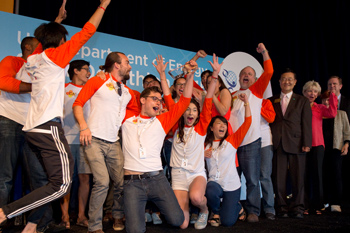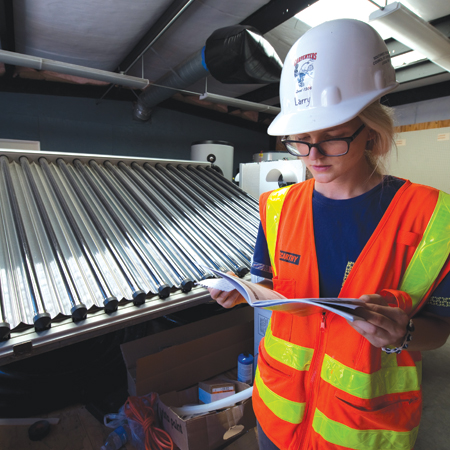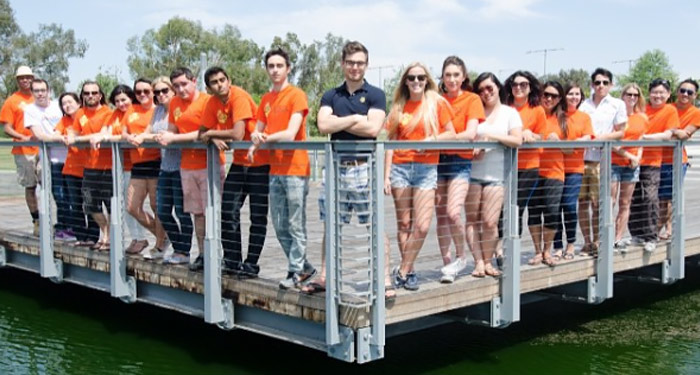Team Orange County, the hometown entry led by University of California, Irvine with Chapman University, Irvine Valley College and Saddleback College, scored big in the prestigious engineering contest at the U.S. Dept. of Energy Solar Decathlon 2015. Jurors praised their net zero energy Casa del Sol home as “the most innovative in the entire competition.”
Judges cited a “dazzling display” of technologies, including a first-ever bi-directional inverter that converts the sun’s rays into direct current to power an electric car, a paraffin lined clothes dryer and other energy-saving features. Team OC scored just one point less in the engineering contest than Stevens Institute of Technology, which won the overall decathlon for their disaster-response themed solar home.
The win on the last day of a grueling two-year competition was met with jubilant cheers and fist pumps. The 100-plus students, faculty and sponsors who worked on Casa del Sol saw some of their unique devices break down during the contest, including a crack in the inverter; the judges’ praise vindicated their boundary-stretching designs and hard work.
“We really pushed the envelope in big ways,” said project engineer Moritz Limpinsel, a UCI graduate student studying chemical and materials physics. “We wanted to show that these new technologies can replace business as usual. It feels great. I’m glad the jury acknowledged our unique designs.”
“Whoooooo! Yahooooo!!” shouted UCI electrical engineering student Euiso Kim behind him. Limpinsel laughed: “Euiso’s right; that says it much better.”
Gregory Washington, dean of the Samueli School of Engineering, and fellow faculty from the four schools beamed.
“These students now believe they have the ability, the know-how, the tenacity, the perseverance to change the world,” Washington said. “And they will literally try to do it.”
“This is what great universities do, they provide opportunities for their students to show just how brilliant and creative and hard-working they are,” said Chapman University political science professor Fred Smoller. “They built a great house and I’m very proud of them.”
Read below for more on Team Orange County and Casa del Sol:
The August forecast calls for triple-digit heat in Irvine, Calif. – for the next week and the next century.
Alex McDonald, 31, a graduate student in engineering at the University of California, Irvine, is unfazed. He gazes at the thick walls of a home taking shape in a corner of the Irvine Valley College campus. “Our house is fully sustainable and comfortable,” he says. “It’s modeled after the California poppy, which opens and closes to the sun. And water is a big concern here in California, so it’s also drought-resistant.”
 Mahdi Jorat, 19, of Saddleback College agrees. “We’re the first generation to fully live with global warming, as this weather shows, and we’re building a house that does something about it,” he says.
Mahdi Jorat, 19, of Saddleback College agrees. “We’re the first generation to fully live with global warming, as this weather shows, and we’re building a house that does something about it,” he says.
“We’re the first generation to fully live with global warming … and we’re building a house that does something about it.” – Mahdi Jorat, 19, UCI engineering major
Over the past two years, they and about 100 other students and faculty from UCI, IVC, Chapman University and Saddleback College have designed an energy-efficient, drought-tolerant, affordable home of the future. Now construction is underway.
Casa del Sol is Orange County’s first-ever entry in this month’s U.S. Department of Energy Solar Decathlon, which challenges college students worldwide to build and live in a zero-net-energy home. That means it must produce and store more electricity than it needs.
For power, the UCI-led team looks to the blazing sun rather than polluting coal. But they leap far beyond standard solar panels, employing innovative residential direct current instead of typical AC/DC, which “leaks” voltage at a high rate; solar thermal radiant cooling in the ceilings; a paraffin-lined dryer that holds heat for multiple loads; and other big energy- and water-saving features.
 The competition process is mind-boggling: Team Orange County had to not only draw sophisticated plans capable of passing tough state codes but also raise about $1 million in donated time, parts and cash. After the concept home is built at IVC, the students must test the plumbing and power to make sure they work, then rip it all down, get it to the Orange County Great Park and rebuild it in a matter of days. There, from Oct. 8 to 18, judges and the public – more than 65,000 at the last decathlon – will get to see them live in and explain their vision.
The competition process is mind-boggling: Team Orange County had to not only draw sophisticated plans capable of passing tough state codes but also raise about $1 million in donated time, parts and cash. After the concept home is built at IVC, the students must test the plumbing and power to make sure they work, then rip it all down, get it to the Orange County Great Park and rebuild it in a matter of days. There, from Oct. 8 to 18, judges and the public – more than 65,000 at the last decathlon – will get to see them live in and explain their vision.







